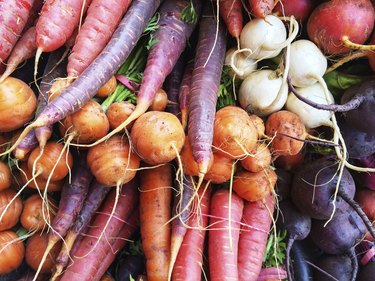
Several different conditions can lead to arthritis, or painful inflammation of your joints. In gout, a metabolic problem can cause joint pain because the body has difficulty getting rid of a waste product in blood called uric acid. Choosing the right foods can help prevent or improve symptoms of gout, with certain vegetables being better choices than others.
Low-Purine Veggies
Video of the Day
Uric acid forms when your body breaks down purines in food. High levels can result from overproduction of uric acid, a problem excreting it in urine or both. As the compound accumulates, it forms needlelike crystals in tissues of joints, eventually causing pain. Choosing low-purine vegetables can help lower blood levels of uric acid, lessening the likelihood of crystal formation if you have gout. A low-purine food generally produces 100 milligrams or less of uric acid per 100 grams of food. Good examples include beets, cucumber, lettuce, potatoes and summer squash, all producing 50 milligrams or less of uric acid in each 100 grams.
Video of the Day
Antioxidant-Rich Vegetables
High uric acid levels in gout might also raise your risk of cardiovascular disease, according to a paper published in 2009 in "Arthritis Research and Therapy." Antioxidants help protect you from free radicals that can damage cells and raise your risk of cardiovascular problems, and the University of Maryland Medical Center recommends eating foods high in antioxidants if you have gout. Vegetables that are low in purine but high in antioxidants such as lycopene, vitamin E or beta-carotene include red cabbage, which is especially high in beta-carotene, with about 600 micrograms in 1 cup of chopped, raw vegetable. Red peppers are also a good choice, with 500 micrograms of lycopene, over 3 milligrams of vitamin E and more than 1,600 micrograms of beta-carotene in 1 cup of sauteed chopped peppers.
High-Fiber Choices
Eating lots of high-fiber vegetables that are also low in purines may be beneficial if you have gout. Dietary fiber supports good digestion and can slow uptake of nutrients, a possible benefit when you're trying to keep your blood uric acid level low. Carrots are good choice, with about 3.5 grams of fiber in 1 cup of chopped raw carrots, plus they're also quite low in purines. Other good choices include chopped, cooked kale, which has 2.6 grams of fiber per cup, and chopped, raw onions, with about 3 grams of fiber in 1 cup. The publication "Dietary Guidelines for Americans, 2010" recommends that adult women consume 25 grams of fiber daily, while men should get 38 grams.
What to Avoid
Although most vegetables are generally lower in purines than high-purine foods such as beef, organ meats and yeast-based foods, some vegetables are moderately rich in purines and should be eaten only occasionally. Examples include asparagus, beans, lentils, mushrooms and dried peas, according to the University of Pittsburgh Medical Center. Limit your intake of these vegetables to no more than two servings per week. Talk to your doctor or a registered dietitian about making food choices that can help prevent or minimize painful symptoms of gout.
- University of Maryland Medical Center: Gout
- MedlinePlus: Gout
- Acumedico: Various Food Types and Their Purine Content
- Centers for Disease Control and Prevention: Gout
- Arthritis Research and Therapy: Gout. Hyperuricemia and Cardiovascular Disease -- How Strong Is the Evidence for a Causal Link?
- USDA National Nutrient Database: Lycopene, Vitamin E, Beta Carotene Vegetables
- USDA National Nutrient Database: Fiber, Total Dietary -- Vegetables and Vegetable Products
- U.S. Department of Agriculture: Dietary Guidelines for Americans, 2010
- University of Pittsburgh Medical Center: Low-Purine Diet
Is this an emergency? If you are experiencing serious medical symptoms, please see the National Library of Medicine’s list of signs you need emergency medical attention or call 911.